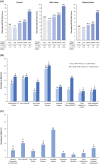Risk of cardiovascular events in patients with hypertriglyceridaemia: A review of real-world evidence
- PMID: 31742844
- PMCID: PMC7065050
- DOI: 10.1111/dom.13921
Risk of cardiovascular events in patients with hypertriglyceridaemia: A review of real-world evidence
Abstract
Aims: To describe the real-world prevalence and consequences of hypertriglyceridaemia.
Materials and methods: We searched two large patient databases, the National Health and Nutrition Examination Survey (NHANES) database (2007-2014) and the Optum Research Database, as well as electronic medical records from two Kaiser Permanente regions.
Results: The NHANES data showed that ~26% of US adults, including nearly one-third of statin users, had at least borderline hypertriglyceridaemia (triglycerides [TGs] ≥1.69 mmol/L), and ~40% of adults with diabetes had levels of ≥150 mg/dL despite statin use. The Optum analyses demonstrated that those with TG levels ≥1.69 mmol/L who were on statins had a significantly increased risk of composite initial major cardiovascular (CV) events (hazard ratio [HR] 1.26, 95% confidence interval [CI] 1.19-1.34; P < 0.001 vs. patients with TGs <150 mg/dL). This was accompanied by increased healthcare utilization and direct healthcare costs (HR 1.12, 95% CI 1.08-1.16; P < 0.001). In the analyses of the Kaiser Permanente records, patients with diabetes and TG levels 2.26-5.64 mmol/L had significantly higher adjusted incidence rates of non-fatal myocardial infarction (rate ratio 1.30, 95% CI 1.08-1.58; P = 0.006), non-fatal stroke (rate ratio 1.23; 95% CI 1.01-1.49; P = 0.037) and coronary revascularization (rate ratio 1.21; 95% CI 1.02-1.43; P = 0.027), but not unstable angina (rate ratio 1.33; 95% CI 0.87-2.03; P = 0.185) compared with patients with TG levels <1.69 mmol/L.
Conclusions: Real-world analyses suggest that elevated TGs are prevalent and commonly associated with increased CV risk. CV outcomes trials in patients with established hypertriglyceridaemia will clarify whether strategies to reduce TG levels can ameliorate residual CV risk in patients taking statins.
Keywords: atherosclerosis; cardiovascular disease; cost-effectiveness; database research; dyslipidaemia; hypertriglyceridaemia.
© 2019 The Authors. Diabetes, Obesity and Metabolism published by John Wiley & Sons Ltd.
Conflict of interest statement
The authors declare the following. P.P.T.: Speakers Bureau: Amarin Pharma Inc., Amgen, Kowa, Merck, Novo‐Nordisk, Regeneron, Sanofi, and Consultant: Amarin Pharma Inc., Amgen, Kowa, Novo‐Nordisk, Resverlogix, Theravance. S.F.: Consultant: Amarin Pharma Inc., Amgen, Esperion, AstraZeneca, Novartis. N.D.W.: Research support: Amarin Pharma Inc., Amgen (through institution); Speakers Bureau: Amarin Pharma Inc., Sanofi, Novartis; and Advisory Boards: Amarin Pharma Inc., Sanofi, Novartis. M.H.: Employment: Optum. G.A.N.: Research funding: Boehringer Ingelheim, Bristol‐Myers Squibb, Merck & Co.
Figures

References
-
- Ganda OP, Bhatt DL, Mason RP, Miller M, Boden WE. Unmet need for adjunctive dyslipidemia therapy in hypertriglyderidemia management. J Am Coll Cardiol. 2018;72(3):330‐343. - PubMed
-
- Rizzo M, Barylski M, Rizvi AA, Montalto G, Mikhailidis DP, Banach M. Combined dyslipidemia: should the focus be LDL cholesterol or atherogenic dyslipidemia? Curr Pharm Des. 2013;19(21):3858‐3868. - PubMed
-
- Miller M, Cannon CP, Murphy SA, Qin J, Ray KK, Braunwald E. Impact of triglyceride levels beyond low‐density lipoprotein cholesterol after acute coronary syndrome in the PROVE IT‐TIMI 22 trial. J Am Coll Cardiol. 2008;51(7):724‐730. - PubMed
-
- Imke C, Rodriguez BL, Grove JS, et al. Are remnant‐like particles independent predictors of coronary heart disease incidence? The Honolulu Heart study. Arterioscler Thromb Vasc Biol. 2005;25(8):1718‐1722. - PubMed
-
- Kugiyama K, Doi H, Takazoe K, et al. Remnant lipoprotein levels in fasting serum predict coronary events in patients with coronary artery disease. Circulation. 1999;99(22):2858‐2860. - PubMed
Publication types
MeSH terms
Substances
LinkOut - more resources
Full Text Sources
Medical
Miscellaneous

